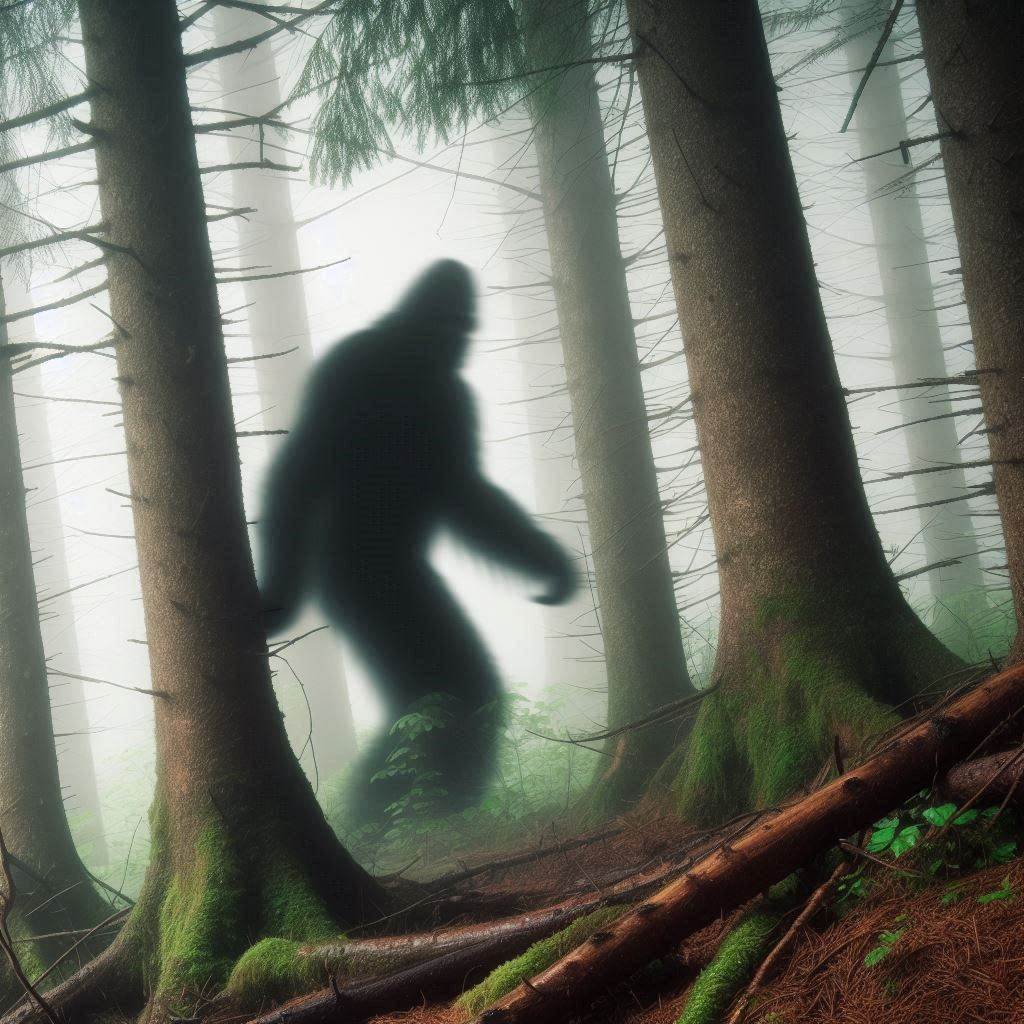Bigfoot and Cryptids: Myth, Mystery, or Reality?
Introduction
For centuries, tales of mysterious creatures lurking in the wilderness have captivated human imagination. From Bigfoot in the dense forests of North America to the Loch Ness Monster in Scotland’s deep waters, cryptids—animals whose existence is debated but unproven—have inspired countless legends, expeditions, and conspiracy theories. While many believe these creatures are remnants of undiscovered species or even supernatural beings, skeptics argue that they are simply the result of misidentifications, hoaxes, or psychological phenomena.
Are these cryptids real, or are they simply folklore perpetuated by exaggeration and wishful thinking? In this article, we will examine some of the most famous cryptid conspiracy theories, analyze the evidence for and against their existence, and separate fact from fiction.
1. Bigfoot: The Elusive Giant of the Forest
The Claim
Bigfoot, also known as Sasquatch, is a massive, ape-like creature reportedly roaming the forests of North America. Descriptions often depict a towering, hairy humanoid with immense strength and stealth capabilities. Believers argue that Bigfoot is a surviving relic of an ancient primate species, possibly a descendant of Gigantopithecus, a prehistoric ape that once lived in Asia.
The Evidence
- Eyewitness Testimonies: Thousands of reports from hunters, hikers, and rural residents claim to have seen a large, bipedal creature lurking in the woods.
- Footprints: Large, human-like footprints measuring up to 24 inches long have been discovered in various locations, particularly in the Pacific Northwest.
- Video and Photographic Evidence: The famous Patterson-Gimlin film from 1967 allegedly captures a walking Bigfoot, fueling debate over its authenticity.
- Audio Recordings: Some researchers claim to have captured eerie howls and wood-knocking sounds believed to be Bigfoot communication.
The Debunking
- Hoaxes and Misidentifications: While the legend of Bigfoot continues to captivate the imagination, a closer examination of the evidence reveals significant reasons to question its existence. One of the most compelling arguments against Bigfoot is the prevalence of hoaxes and misidentifications. Over the years, numerous footprint discoveries and video clips have been debunked as elaborate pranks. For instance, individuals have come forward admitting to creating fake footprints using wooden carvings or wearing oversized boots. Similarly, the iconic Patterson-Gimlin film, often hailed as the most convincing evidence of Bigfoot, has been scrutinized by experts who suggest it could easily depict a person in a costume. The lack of clear, unambiguous footage in the age of high-resolution cameras and smartphones further undermines the credibility of such claims.
- Lack of Physical Remains: Another critical point is the absence of physical remains. Despite decades of searching, no verifiable bones, teeth, or carcasses of Bigfoot have ever been discovered. Given the creature’s purported size and habitat, it’s highly improbable that not a single specimen has been found, especially in regions frequently explored by humans. Large mammals, particularly those as massive as Bigfoot is described, leave behind traces such as nests, feeding sites, or skeletal remains. The complete lack of such evidence suggests that Bigfoot may be more myth than reality.
- Biological Improbability: From a biological standpoint, the existence of Bigfoot faces significant challenges. To sustain a viable population, a species requires a substantial number of individuals to avoid inbreeding and ensure genetic diversity. For a creature as large as Bigfoot, this would necessitate a considerable amount of territory and resources, making it nearly impossible for such a population to remain hidden for so long. Additionally, the ecological impact of a large, omnivorous primate would likely be noticeable, yet no such disturbances have been documented in the regions where Bigfoot is said to roam.
Fact-Checking
2. The Loch Ness Monster: Scotland’s Legendary Serpent
The Claim
The Loch Ness Monster, or “Nessie,” is said to be a large, long-necked aquatic creature living in Scotland’s Loch Ness. Believers suggest it could be a surviving plesiosaur, an extinct marine reptile, or an undiscovered species yet to be classified.
The Evidence
- Photographs and Videos: The infamous “Surgeon’s Photograph” from 1934 appears to show a long-necked creature emerging from the water.
- Sonar Readings: Multiple sonar scans of Loch Ness have detected large, unidentified moving objects in the depths.
- Eyewitness Reports: Locals and tourists alike have claimed to see Nessie, often describing a long-necked, hump-backed creature swimming in the lake.
The Debunking
- Hoaxes and Misinterpretations: The Surgeon’s Photograph was later revealed to be a hoax, showing a toy submarine with a fake head. Many other images have been proven to be fakes or photographic distortions.
- Natural Explanations: Many sightings can be attributed to floating logs, wave patterns, or large fish such as sturgeon. Optical illusions caused by light reflections can also make ordinary objects appear monstrous.
- Lack of Biological Evidence: Extensive scientific studies, including sonar sweeps and environmental DNA analysis, have failed to find any credible evidence of a large unknown creature in the loch. Scientists conclude that if a large aquatic animal existed in the lake, its biological traces would be detectable.
Fact-Checking
3. Chupacabra: The Bloodsucking Beast
The Claim
The Chupacabra, or “goat-sucker,” is a cryptid said to drain the blood of livestock, particularly in Puerto Rico, Mexico, and the southern U.S. Descriptions vary, with some depicting a reptilian creature with spikes, while others describe a hairless, dog-like animal.
The Evidence
- Farmers’ Reports: Many farmers have discovered livestock with puncture wounds and no blood, allegedly the work of the Chupacabra.
- Sightings: Numerous people have reported encountering the creature, describing glowing red eyes and an eerie presence.
- Carcasses of Strange Animals: Some dead animals found in the wild resemble descriptions of the Chupacabra.
The Debunking
- Mangy Coyotes: Biologists have identified many alleged Chupacabra specimens as coyotes suffering from severe mange, which alters their appearance and causes them to lose fur, making them look monstrous.
- Natural Predation: Livestock deaths attributed to Chupacabras often have more mundane explanations, such as known predators (coyotes, mountain lions, and feral dogs) or diseases. Blood loss in dead animals can be due to post-mortem pooling rather than mysterious drainage.
- Urban Legends and Fear: The Chupacabra legend emerged in the 1990s, showing strong influences from pop culture and media sensationalism. The earliest descriptions seem to have been inspired by science fiction movies rather than actual biological creatures.
Fact-Checking
Conclusion
Cryptid legends like Bigfoot, the Loch Ness Monster, and the Chupacabra continue to capture public fascination, blending myth, mystery, and occasional evidence into an ongoing debate. While eyewitness accounts, alleged footprints, and video recordings fuel belief, the lack of definitive physical evidence and scientific scrutiny often debunks these claims.
Skepticism is crucial when evaluating cryptid claims. Psychological phenomena, hoaxes, and natural explanations account for most reported sightings. Yet, the appeal of the unknown keeps these legends alive. Whether they are undiscovered species or simply misinterpretations of natural phenomena, cryptids remain an intriguing part of human storytelling. For those who believe, the search continues. But for skeptics, the answer is clear—without verifiable proof, these creatures remain firmly in the realm of myth.

